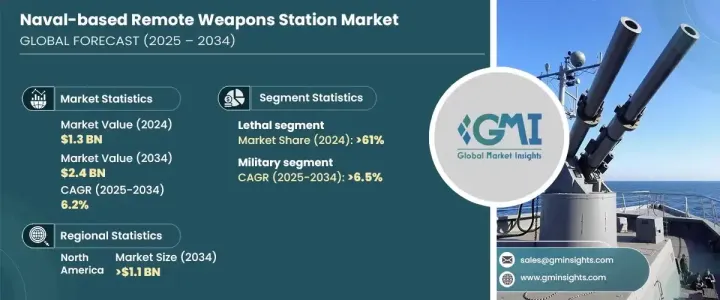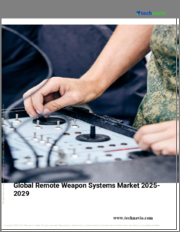
|
시장보고서
상품코드
1684635
해군 기반 원격 무기 스테이션 시장 : 기회, 성장 촉진요인, 산업 동향 분석(2025-2034년)Naval-based Remote Weapons Station Market Opportunity, Growth Drivers, Industry Trend Analysis, and Forecast 2025 - 2034 |
||||||
세계의 해군 기반 원격 무기 스테이션(RWS) 시장은 2024년에 13억 달러로 평가되었고, 2025년부터 2034년에 걸쳐 6.2%의 연평균 성장률(CAGR)로 성장할 것으로 예측됩니다.
이러한 성장은 진화하는 해양 위협에 대응하기 위해 해군 함대를 현대화하고 첨단 기술을 채택하는 것이 점점 더 강조되고 있음을 반영합니다. 원격 무기 스테이션(RWS)은 정밀 타겟팅을 강화하고, 작전 효율성을 강화하며, 중요한 임무 수행 중 승무원을 보호하는 데 필수 불가결한 요소가 되었습니다.

세계의 해양 활동이 강화됨에 따라 소형 경량 원격 제어 무기 시스템에 대한 수요가 계속 증가하고 있습니다. 이러한 시스템은 광범위한 해군 작전 전반에 걸쳐 방어 능력을 강화하는 데 중추적인 역할을 합니다. 또한 자동화 및 AI 기반 기술과의 통합이 발전하면서 RWS의 운영 가치가 높아져 까다로운 해양 환경에서도 뛰어난 성능을 발휘할 수 있게 되었습니다. 전 세계적으로 선단 현대화와 무인 수상 선박의 통합이 추진되면서 시장 확대가 더욱 가속화되고 있습니다.
| 시장 범위 | |
|---|---|
| 시작 연도 | 2024년 |
| 예측 연도 | 2025-2034년 |
| 시작 금액 | 13억 달러 |
| 예측 금액 | 24억 달러 |
| CAGR | 6.2% |
시장은 무기 유형에 따라 살상 시스템과 비살상 시스템으로 분류되며, 2024년에는 살상 시스템이 61%의 점유율을 차지할 것으로 예상됩니다. 이 부문의 성장은 12.7mm에서 20mm에 이르는 기관총과 대포와 같은 대구경 무기의 배치에 의해 주도되고 있습니다. 이러한 무기는 탁월한 화력을 제공하여 빠르게 움직이는 위협에 대응하고 근거리 전투 작전을 수행하는 데 필수적인 것으로 입증되었습니다. 정밀유도탄의 통합은 고가 또는 회피 표적을 탁월한 정확도로 무력화할 수 있는 능력을 더욱 향상시켜 현대 해군 방어 전략에 없어서는 안 될 필수 요소입니다. 해양 위협이 진화함에 따라 이러한 첨단 무기 시스템 배치에 대한 관심은 계속 높아질 것입니다.
용도별로 보면 시장은 군사 및 국토 안보로 분류되며, 군사 부문은 2034년까지 6.5%의 놀라운 연평균 성장률을 보일 것으로 예상됩니다. 원격 무기 스테이션과 무인 수상함 및 드론의 통합이 증가함에 따라 작전 효율성이 크게 향상되고 있습니다. 이러한 협업은 상황 인식, 표적 정밀도, 전반적인 전투 의사 결정을 향상시켜 다양한 해양 영역에서 전략적 우위를 확보할 수 있게 해줍니다. 또한 최첨단 인공 지능과 센서 기술의 도입으로 표적 정확도가 혁신적으로 향상되어 역동적인 위협에 신속하고 효과적으로 대응할 수 있게 되었습니다. 이러한 혁신은 해군 기반 원격 무기 스테이션 시장의 핵심 성장 동력으로서 군사 부문의 입지를 더욱 공고히 하고 있습니다.
북미는 2034년까지 해군 기반 원격 무기 스테이션 부문에서 11억 달러의 매출을 올릴 것으로 예상되는 등 시장을 지배할 것으로 보입니다. 이러한 성장은 미국이 기술 발전과 함대 현대화 이니셔티브에 집중하고 있는 것이 뒷받침하고 있습니다. 자동화, 인공 지능 및 모듈식 시스템의 통합은 유인 및 무인 플랫폼에서 원활한 운영을 보장하여 다중 도메인 운영 능력을 향상시킵니다. 혁신과 첨단 방위 솔루션에 중점을 두고 있는 북미는 해군 기반 원격 무기 스테이션 시장의 미래를 계속해서 주도하고 있습니다.
목차
제1장 조사 방법과 조사 범위
- 시장 범위와 정의
- 기본 추정과 계산
- 예측 계산
- 데이터 소스
- 1차 데이터
- 2차 데이터
- 유료
- 공적
제2장 주요 요약
제3장 업계 인사이트
- 생태계 분석
- 밸류체인에 영향을 주는 요인
- 이익률 분석
- 혼란
- 장래 전망
- 제조업체
- 유통업체
- 공급자의 상황
- 이익률 분석
- 주요 뉴스
- 규제 상황
- 영향요인
- 성장 촉진요인
- 지속적인 글로벌 해군 현대화 노력
- 지역 분쟁 및 해양 안보 위협 증가
- 해군 작전에서 무인 수상정(USV)과 드론의 사용 증가
- AI, 자동화 및 센서 기술의 발전
- 승무원 안전 및 운영 효율성에 집중
- 업계의 잠재적 위험 및 과제
- 높은 개발 및 인수 비용
- 레거시 시스템과의 통합
- 성장 촉진요인
- 성장 가능성 분석
- Porter's Five Forces 분석
- PESTEL 분석
제4장 경쟁 구도
- 소개
- 기업 점유율 분석
- 경쟁 포지셔닝 매트릭스
- 전략 전망 매트릭스
제5장 시장 추계 및 예측 : 플랫폼별(2021-2034년)
- 주요 동향
- 구축함
- 프리게이트
- 코르벳
- 순찰 및 기뢰 대책 선박
- 연안 순찰선(OPV)
- 수륙 양용 선박
- 무인 수상 차량
제6장 시장 추계 및 예측 : 컴포넌트별(2021-2034년)
- 주요 동향
- 무기
- 비전 시스템
제7장 시장 추계 및 예측 : 무기 유형별(2021-2034년)
- 주요 동향
- 살상 무기
- 소구경
- 5.56mm
- 7.62mm
- 12.7mm
- 중구경
- 20mm
- 25mm
- 30mm
- 40mm
- 소구경
- 비살상 무기
제8장 시장 추계 및 예측 : 용도별(2021-2034년)
- 주요 동향
- 군사
- 국토 안보
제9장 시장 추계 및 예측 : 지역별(2021-2034년)
- 주요 동향
- 북미
- 미국
- 캐나다
- 유럽
- 영국
- 독일
- 프랑스
- 이탈리아
- 스페인
- 러시아
- 아시아태평양
- 중국
- 인도
- 일본
- 한국
- 호주
- 라틴아메리카
- 브라질
- 멕시코
- 중동 및 아프리카
- 남아프리카
- 사우디아라비아
- 아랍에미리트(UAE)
제10장 기업 프로파일
- Aselsan
- BAE Systems
- Bharat Electronics
- Copenhagen Sensor Technology
- Elbit Systems
- EVPU Defense
- FN Herstal
- General Dynamics
- Israel Aerospace Industries
- Kongsberg Gruppen
- Leonardo
- Northrop Grumman
- Rafael Advanced Defense Systems
- Raytheon Technologies
- Rheinmetall
- Saab
- Singapore Technologies Engineering
- Thales
The Global Naval-Based Remote Weapons Station Market was valued at USD 1.3 billion in 2024 and is projected to grow at a robust CAGR of 6.2% between 2025 and 2034. This growth reflects the increasing emphasis on modernizing naval fleets and adopting advanced technologies to address evolving maritime threats. Remote weapons stations (RWS) have become indispensable for enhancing precision targeting, bolstering operational efficiency, and safeguarding crew members during critical missions.

As global maritime activities intensify, the demand for compact, lightweight, and remote-controlled weapon systems continues to rise. These systems are pivotal in strengthening defense capabilities across a wide range of naval operations. Additionally, advancements in automation and integration with AI-driven technologies have elevated the operational value of RWS, enabling superior performance in challenging maritime environments. The global push toward fleet modernization and the integration of unmanned surface vessels further accelerates market expansion.
| Market Scope | |
|---|---|
| Start Year | 2024 |
| Forecast Year | 2025-2034 |
| Start Value | $1.3 billion |
| Forecast Value | $2.4 billion |
| CAGR | 6.2% |
The market is categorized by weapon type into lethal and non-lethal systems, with lethal systems commanding a 61% share in 2024. This segment's growth is driven by the deployment of high-caliber armaments, such as machine guns and cannons ranging from 12.7mm to 20mm. These weapons deliver unparalleled firepower, proving essential in countering fast-moving threats and executing close-range combat operations. The integration of precision-guided munitions further enhances the capability to neutralize high-value or evasive targets with exceptional accuracy, making them indispensable for modern naval defense strategies. As maritime threats evolve, the focus on deploying these advanced weapon systems will remain strong.
Based on application, the market is segmented into military and homeland security, with the military segment expected to grow at an impressive CAGR of 6.5% through 2034. The increasing integration of remote weapons stations with unmanned surface vessels and drones significantly boosts their operational effectiveness. These collaborations enhance situational awareness, targeting precision, and overall combat decision-making, ensuring a strategic edge across various maritime domains. Additionally, the adoption of cutting-edge artificial intelligence and sensor technologies revolutionizes targeting accuracy, enabling swift and effective responses to dynamic threats. This innovation further solidifies the position of the military sector as a key driver of growth in the naval-based remote weapons station market.
North America is set to dominate the market, with its naval-based remote weapons station segment expected to generate USD 1.1 billion by 2034. This growth is underpinned by the United States' focus on technological advancements and fleet modernization initiatives. The integration of automation, artificial intelligence, and modular systems ensures seamless operation across manned and unmanned platforms, enhancing multi-domain operational capabilities. With its emphasis on innovation and advanced defense solutions, North America continues to lead in shaping the future of the naval-based remote weapons station market.
Table of Contents
Chapter 1 Methodology & Scope
- 1.1 Market scope & definitions
- 1.2 Base estimates & calculations
- 1.3 Forecast calculations
- 1.4 Data sources
- 1.4.1 Primary
- 1.4.2 Secondary
- 1.4.2.1 Paid sources
- 1.4.2.2 Public sources
Chapter 2 Executive Summary
- 2.1 Industry synopsis, 2021-2034
Chapter 3 Industry Insights
- 3.1 Industry ecosystem analysis
- 3.1.1 Factor affecting the value chain
- 3.1.2 Profit margin analysis
- 3.1.3 Disruptions
- 3.1.4 Future outlook
- 3.1.5 Manufacturers
- 3.1.6 Distributors
- 3.2 Supplier landscape
- 3.3 Profit margin analysis
- 3.4 Key news & initiatives
- 3.5 Regulatory landscape
- 3.6 Impact forces
- 3.6.1 Growth drivers
- 3.6.1.1 Ongoing global naval modernization efforts
- 3.6.1.2 Escalating regional conflicts and maritime security threats
- 3.6.1.3 Increasing use of unmanned surface vessels (USVs) and drones in naval operations
- 3.6.1.4 Advancements in AI, automation, and sensor technologies
- 3.6.1.5 Focus on crew safety and operational efficiency
- 3.6.2 Industry pitfalls & challenges
- 3.6.2.1 High development and acquisition costs
- 3.6.2.2 Integration with legacy systems
- 3.6.1 Growth drivers
- 3.7 Growth potential analysis
- 3.8 Porter's analysis
- 3.9 PESTEL analysis
Chapter 4 Competitive Landscape, 2024
- 4.1 Introduction
- 4.2 Company market share analysis
- 4.3 Competitive positioning matrix
- 4.4 Strategic outlook matrix
Chapter 5 Market Estimates & Forecast, By Platform, 2021-2034 (USD Million & Units)
- 5.1 Key trends
- 5.2 Destroyers
- 5.3 Frigates
- 5.4 Corvettes
- 5.5 Patrol & mine countermeasures vessels
- 5.6 Offshore patrol vessels(OPVs)
- 5.7 Amphibious vessels
- 5.8 Unmanned surface vehicles
Chapter 6 Market Estimates & Forecast, By Components, 2021-2034 (USD Million & Units)
- 6.1 Key trends
- 6.2 Weaponry
- 6.3 Vision systems
Chapter 7 Market Estimates & Forecast, By Weapon Type, 2021-2034 (USD Million & Units)
- 7.1 Key trends
- 7.2 Lethal weapons
- 7.2.1 Small caliber
- 7.2.1.1 5.56mm
- 7.2.1.2 7.62mm
- 7.2.1.3 12.7mm
- 7.2.2 Medium caliber
- 7.2.2.1 20mm
- 7.2.2.2 25mm
- 7.2.2.3 30mm
- 7.2.2.4 40mm
- 7.2.1 Small caliber
- 7.3 Non-lethal weapons
Chapter 8 Market Estimates & Forecast, By Application, 2021-2034 (USD Million & Units)
- 8.1 Key trends
- 8.2 Military
- 8.3 Homeland security
Chapter 9 Market Estimates & Forecast, By Region, 2021-2034 (USD Million & Units)
- 9.1 Key trends
- 9.2 North America
- 9.2.1 U.S.
- 9.2.2 Canada
- 9.3 Europe
- 9.3.1 UK
- 9.3.2 Germany
- 9.3.3 France
- 9.3.4 Italy
- 9.3.5 Spain
- 9.3.6 Russia
- 9.4 Asia Pacific
- 9.4.1 China
- 9.4.2 India
- 9.4.3 Japan
- 9.4.4 South Korea
- 9.4.5 Australia
- 9.5 Latin America
- 9.5.1 Brazil
- 9.5.2 Mexico
- 9.6 MEA
- 9.6.1 South Africa
- 9.6.2 Saudi Arabia
- 9.6.3 UAE
Chapter 10 Company Profiles
- 10.1 Aselsan
- 10.2 BAE Systems
- 10.3 Bharat Electronics
- 10.4 Copenhagen Sensor Technology
- 10.5 Elbit Systems
- 10.6 EVPU Defense
- 10.7 FN Herstal
- 10.8 General Dynamics
- 10.9 Israel Aerospace Industries
- 10.10 Kongsberg Gruppen
- 10.11 Leonardo
- 10.12 Northrop Grumman
- 10.13 Rafael Advanced Defense Systems
- 10.14 Raytheon Technologies
- 10.15 Rheinmetall
- 10.16 Saab
- 10.17 Singapore Technologies Engineering
- 10.18 Thales



















